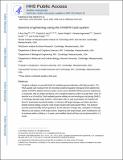| dc.contributor.author | Ran, F. Ann | |
| dc.contributor.author | Hsu, Patrick | |
| dc.contributor.author | Wright, Jason | |
| dc.contributor.author | Agarwala, Vineeta | |
| dc.contributor.author | Scott, David Arthur | |
| dc.contributor.author | Zhang, Feng | |
| dc.date.accessioned | 2016-06-03T17:39:44Z | |
| dc.date.available | 2016-06-03T17:39:44Z | |
| dc.date.issued | 2013-11 | |
| dc.identifier.issn | 1754-2189 | |
| dc.identifier.issn | 1750-2799 | |
| dc.identifier.uri | http://hdl.handle.net/1721.1/102943 | |
| dc.description | available in PMC 2014 March 30 | en_US |
| dc.description.abstract | Targeted nucleases are powerful tools for mediating genome alteration with high precision. The RNA-guided Cas9 nuclease from the microbial clustered regularly interspaced short palindromic repeats (CRISPR) adaptive immune system can be used to facilitate efficient genome engineering in eukaryotic cells by simply specifying a 20-nt targeting sequence within its guide RNA. Here we describe a set of tools for Cas9-mediated genome editing via nonhomologous end joining (NHEJ) or homology-directed repair (HDR) in mammalian cells, as well as generation of modified cell lines for downstream functional studies. To minimize off-target cleavage, we further describe a double-nicking strategy using the Cas9 nickase mutant with paired guide RNAs. This protocol provides experimentally derived guidelines for the selection of target sites, evaluation of cleavage efficiency and analysis of off-target activity. Beginning with target design, gene modifications can be achieved within as little as 1–2 weeks, and modified clonal cell lines can be derived within 2–3 weeks. | en_US |
| dc.description.sponsorship | National Institutes of Health (U.S.) (NIH Transformative R01 grant (R01-DK097768)) | en_US |
| dc.description.sponsorship | National Institutes of Health (U.S.) (NIH Director’s Pioneer Award (DP1-MH100706)) | en_US |
| dc.description.sponsorship | National Institutes of Health (U.S.) (NIH Training Grant T32GM008313) | en_US |
| dc.description.sponsorship | National Institutes of Health (U.S.) (NIH Training Grant T32GM007753) | en_US |
| dc.description.sponsorship | National Science Foundation (U.S.) ((NSF) pre-doctoral fellow) | en_US |
| dc.language.iso | en_US | |
| dc.publisher | Nature Publishing Group | en_US |
| dc.relation.isversionof | http://dx.doi.org/10.1038/nprot.2013.143 | en_US |
| dc.rights | Article is made available in accordance with the publisher's policy and may be subject to US copyright law. Please refer to the publisher's site for terms of use. | en_US |
| dc.source | PMC | en_US |
| dc.title | Genome engineering using the CRISPR-Cas9 system | en_US |
| dc.type | Article | en_US |
| dc.identifier.citation | Ran, F Ann, Patrick D Hsu, Jason Wright, Vineeta Agarwala, David A Scott, and Feng Zhang. “Genome Engineering Using the CRISPR-Cas9 System.” Nature Protocols 8, no. 11 (October 24, 2013): 2281–2308. | en_US |
| dc.contributor.department | Massachusetts Institute of Technology. Department of Biological Engineering | en_US |
| dc.contributor.department | Massachusetts Institute of Technology. Department of Brain and Cognitive Sciences | en_US |
| dc.contributor.department | McGovern Institute for Brain Research at MIT | en_US |
| dc.contributor.mitauthor | Hsu, Patrick | en_US |
| dc.contributor.mitauthor | Scott, David Arthur | en_US |
| dc.contributor.mitauthor | Zhang, Feng | en_US |
| dc.relation.journal | Nature Protocols | en_US |
| dc.eprint.version | Author's final manuscript | en_US |
| dc.type.uri | http://purl.org/eprint/type/JournalArticle | en_US |
| eprint.status | http://purl.org/eprint/status/PeerReviewed | en_US |
| dspace.orderedauthors | Ran, F Ann; Hsu, Patrick D; Wright, Jason; Agarwala, Vineeta; Scott, David A; Zhang, Feng | en_US |
| dspace.embargo.terms | N | en_US |
| dc.identifier.orcid | https://orcid.org/0000-0003-2782-2509 | |
| dc.identifier.orcid | https://orcid.org/0000-0002-2639-9879 | |
| mit.license | PUBLISHER_POLICY | en_US |
